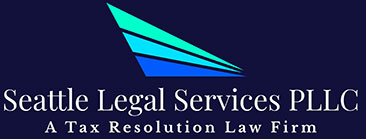IRS CP77: What to Expect If You Get This Notice

Receiving correspondence from the IRS is generally cause for concern, but when you receive IRS Notice CP77, you should be prompted to take immediate action. Without immediate action, you risk losing your assets to the IRS, including your home, vehicles, wages, and bank accounts. As soon as you receive this notice, you should read it thoroughly and decide what your next steps are.
To get help now, contact us at Seattle Legal Services today. We can help you set up payments or explore other resolution options with the IRS. We can also stop many collection actions that are pending or in progress. Don’t let the IRS start seizing your assets. Instead, get help today.
What is the IRS CP77 Notice?
When you owe taxes, the IRS begins sending you notices to attempt to collect what you owe. Initially, these notices simply remind you of how much you owe and give you different ways to pay. But if you do not respond to any of the notices you receive, you may eventually receive Notice CP77, Intent to Seize Your Assets and Notice of Your Right to a Hearing. This is the IRS’s 30-day notice telling you that they will levy your assets if you do not request a hearing or otherwise address your tax debt.
Information on Your Notice
Notice CP77 includes all of the information you need to figure out what the IRS is asking for, what your options are, and what will happen if you continue to fail to pay your tax debt. In the upper right corner of the notice, you’ll find the notice number and date, your SSN, the IRS phone number, and a unique caller ID that you’ll use if you call in.
From there, the notice breaks down the amount you currently owe, divided by the initial tax amount, your accrued interest, and your current penalties. The next section explains your options and how you can choose to respond to this notice. The notice also explains the penalties added to your tax bill and an overview of the documents that arrived with CP77.
When the IRS Sends This Notice Out
This notice is sent out 30 days before the IRS plans on levying your assets. It is the last in a long line of official communication and memos from the IRS, giving you different options to pay your tax debt and avoid levies. Under the Internal Revenue Code, this notice satisfies the agency’s legal requirements before initiating a levy.
What Options Do I Have After Receiving a CP77 Notice?
Finding out that the IRS is on the verge of seizing your home, vehicles, wages, or savings is alarming—so it’s crucial that you review your options and take action immediately. Legally, the IRS is permitted to levy assets as soon as 30 days after the notice date listed on your CP77. Once they have levied your assets, it is very difficult to stop the process and reverse it. That’s why you must take advantage of this window of time and try to find another way to pay your tax debt.
If You Agree With the Assessment
If you agree that you owe the amount listed, you do not have to dispute the amount owed in a Collection Due Process hearing. You can still contact the IRS directly to explore other payment options, such as an installment agreement or offer in compromise. You can also reach out to a tax professional in your area to figure out which type of payment arrangement is best suited to your financial situation and circumstances.
Remember that you should take steps immediately to address your tax debt to avoid a levy. If at all possible, paying in full is the best way to avoid additional interest and penalties. But if this isn’t an option—and it isn’t for most taxpayers who find themselves in this situation—talking to the IRS or a tax professional is your next step.
You may also be able to request penalty abatement, even if you agree that you owe the amount listed on your notice. The IRS may offer penalty relief if you receive erroneous written advice from the IRS or if you have a legitimate reason for being unable to pay your taxes until this notice. For example, a serious injury or illness may warrant penalty abatement. Depending on how long your tax debt has been accruing, penalty abatement could save you a significant amount of money.
If You Disagree With the Assessment
If you do not believe you owe the amount listed on your tax bill, this is your chance to request a Collection Due Process hearing. Your hearing will take place in front of the IRS Independent Office of Appeals. You can dispute the amount you owe if you have not had a prior chance to do so and provide proof that you have either made payments or that the calculated tax amount is incorrect. Should the CDP hearing not go your way, you can still appeal the decision with the U.S. Tax Court.
Again, please request a hearing immediately upon receiving CP77. Thirty days is not a long period of time, and you want to get a hearing scheduled long before the IRS begins moving forward with a levy.
If you miss this deadline, you have up to a year to request an equivalent hearing. This option offers a similar process as the CDP hearing but with key differences. One, you cannot appeal the results of the equivalent hearing. Two, if you wait longer than 30 days, collection actions (asset seizures, bank account freezes, wage garnishments, etc) may have already started on your account.
Consequences of Ignoring This Notice
What happens if you simply ignore IRS Notice CP77? The IRS will wait the legally required 30 days and then move forward with a levy when they see fit. Depending on what you have and how much you earn, the IRS may seize your home, vehicles, personal assets and property, saved money, or wages.
Wage garnishment is ongoing, and the IRS can continue to take the legally allowed amount every pay period until you have paid off your tax debt in full. Note that the garnishment limits in place for other creditors are completely different from the limits in place for the IRS, and IRS wage garnishment could leave you with very little to live on.
The IRS’s Next Steps After Sending CP77
What the IRS does next depends entirely on how you respond to Notice CP77. If you request an alternate payment arrangement, they will process your application and temporarily halt collection activities while they determine whether or not you qualify for the payment plan you have requested. If you pay in full, they will halt collection activities and you will once again be on good terms with the IRS. If you do not respond to the notice, expect to have your assets levied at any point after the 30-day window has closed.
What to Do If You Cannot Pay in Full
Don’t despair if you have received this notice and you cannot pay your tax debt in full. Most people can’t or otherwise, they would have done so before reaching the point of a levy. The IRS simply wants to collect what taxpayers owe; they don’t want to leave people destitute and unable to fulfill their other financial obligations. That’s why they offer many other payment options.
Consider the options listed below, and to get more specialized information on which solutions best fit your financial needs, reach out to a tax professional at Seattle Legal Services.
- Currently not collectible: Those who are genuinely unable to make any progress on their tax debt may ask the IRS to consider them currently not collectible. You may qualify for this status if you have such limited income and assets that any payments on your taxes would leave you in a state of financial hardship. Penalties and interest continue accruing while you are not collectible. Additionally, the IRS will review your finances from time to time—and when they decide that you are collectible once again, they will resume collection activities.
- Partial payment installment agreement: Those who can make some form of monthly payment but not the minimum required payment for an installment agreement may qualify for a partial payment installment agreement. With this plan, you make smaller payments every month until your tax bill reaches the Collection Statute Expiration Date. Once that date passes, the IRS ceases collection activities on the remaining balance.
- Offer in compromise: This option essentially allows you to settle your tax debt for less than you currently owe. The IRS reserves this option for those who have some money to put toward their tax debt, but not enough to pay it off in full. To qualify for this option, you must provide a detailed look at your finances, including your income sources, assets, and all equity held in your assets. If your offer is accepted, you may pay in one lump sum or over an extended period of time.
- Installment agreement: This is often one of the easiest and most widely available options for taxpayers. Many people are able to pay their tax debt over time even if they cannot make one lump sum payment. With a long-term installment agreement, you can stretch your payments over a period as long as 72 months (even longer in select cases). To stay compliant with IRS requirements, you must make all payments on time, pay all new taxes due by their due dates, and file all tax returns on time.
When It’s Time to Reach Out for Professional Assistance
When you are in danger of having assets levied, it is time to talk to a tax professional about your next steps. There are very real financial implications that come with an asset levy, and trying to unwind a levy is much more laborious and time-consuming than taking action before the IRS has started collecting.
When you choose the team at Seattle Legal Services, we can help you review your financial situation, explain different payment options, and develop a plan that gets you caught up on your taxes without putting you in a tough financial situation. Call us at 206-536-3152 or contact us online to schedule a consultation.
